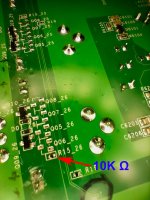Hi Roy,
Here the whole process is shown. As far as I saw, the guy did not mention, that the new caps have to be put in in reverse direction.
Please see posts #3 and #5 above by Brian Ingwell. I don't think any of us were aware of this issue until he mentioned it. I certainly wasn't. This is one of the problems with making schematics and service bulletins secret, as in the case of QSC and most other companies these days.
However, from an electronics perspective, the polarity situation makes complete sense... These are effectively blocking caps in the circuit design. If you are expecting to block a large positive DC voltage (eg phantom power) with a polarized capacitor of any type (in this case electrolytic), then the PLUS terminal of the capacitor MUST go to the point / connector / pin where you expect to receive this + voltage. Polarized capacitors are easily destroyed by applying reverse voltages. Under certain conditions, the explosion can be quite spectacular. In other cases, the top will bulge, and it merely stops acting like a capacitor.
If this doesn't make too much sense to you / you don't have an electronics background, then at least show this thread to your tech, I'm sure he will agree that this makes sense.
I reviewed the video, it is correct, other than the tech continued with the new caps installed backwards. At this point, I believe installing the caps backwards will only come back to bite you if the mixer gets connected to a FoH board with phantom power enabled. I do not imagine any other situation where a significant positive DC voltage would be applied to the AUX outputs... but there are others on this forum more versed in modern sound reinforcement practices, thus I could be wrong.
The Touchmix +48 only goes the the input jacks on a case by case basis if enabled in the software. It is never routed to the output jacks. Most likely just a coincidence that your auxes failed in a time period when you used +48v. My TM8 was stored (climate controlled office) for the entire pandemic, it went bad just sitting around doing nothing. Electronics can be funny that way.
Last edited:

